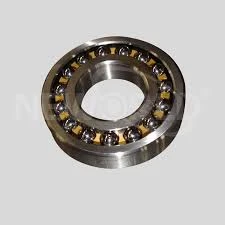
Sep . 23, 2024 19:20 Back to list
Exploring the Benefits and Applications of Small Thrust Bearings in Various Industries
Understanding Small Thrust Bearings Key Components and Their Applications
Thrust bearings play a critical role in various mechanical and industrial applications by accommodating axial loads. Among the different types of thrust bearings, small thrust bearings are particularly important for compact and precision-engineered devices. These bearings are designed to support axial forces while maintaining low friction and enabling smooth rotational motion. In this article, we will explore the characteristics, design, materials, and applications of small thrust bearings and their significance in modern engineering.
Characteristics of Small Thrust Bearings
Small thrust bearings are engineered to handle axial loads in confined spaces. They are generally characterized by a small diameter and lightweight construction, making them suitable for applications where space is at a premium. These bearings often consist of two main components the thrust washer and the roller or ball, which engages with the washer to provide the necessary load support. The design of small thrust bearings varies significantly based on their intended application, with options for both friction-reducing ball and roller configurations.
The load capacity of small thrust bearings is influenced by several factors, including the material types, lubrication methods, and the overall design geometry. For applications requiring high precision and low play, manufacturers often utilize advanced design techniques and materials to ensure consistent performance and durability.
Design and Materials
The design of small thrust bearings is crucial for their performance and longevity. Common designs include flat thrust washers and spherical or conical configurations, which allow for greater load distribution and lower wear rates. The size and configuration of the bearing are tailored to accommodate specific application requirements, such as the type of loads, rotational speeds, and operating environments.
Materials used in the construction of small thrust bearings include stainless steel, bronze, and various composites, each offering different benefits. Stainless steel bearings are notable for their corrosion resistance and strength, making them suitable for demanding applications. Bronze bearings provide excellent wear resistance and thermal conductivity, while composite materials may be chosen for their lightweight properties and low-friction characteristics.
Lubrication
Proper lubrication is essential for the efficient operation of small thrust bearings. Lubricants reduce friction between the moving parts, preventing wear, overheating, and potential failure. Depending on the application, different lubrication methods can be employed, including oil, grease, or self-lubricating materials. Selecting the right lubricant is vital in ensuring the longevity and performance of the bearing, particularly under varying load conditions and environmental factors.
small thrust bearings

Applications of Small Thrust Bearings
Small thrust bearings find extensive use across a wide range of industries due to their compact size and efficient load handling. Some common applications include
1. Electrical motors In applications such as miniature motors or servos, small thrust bearings support the axial loads generated by the rotor. This context is typical in robotics, drones, and small appliances.
2. Automotive components Small thrust bearings are employed in various automotive systems, including electric window mechanisms and transmission assemblies, where space constraints and axial loads are prevalent.
3. Aerospace The aerospace industry relies on small thrust bearings in various systems, such as control surfaces and landing gear mechanisms, where every gram counts, and reliability is paramount.
4. Industrial machinery Small thrust bearings are utilized in conveyor systems, pumps, and gearboxes where they can efficiently manage axial loads while contributing to the overall compact design of the machinery.
5. Watchmaking Precision timepieces often employ small thrust bearings to reduce friction between moving components, enhancing the lifetime and accuracy of the watch.
Conclusion
Small thrust bearings are indispensable components in many engineering applications, providing efficient load handling and facilitating smooth motion in confined environments. Their design, materials, and lubrication methods play a crucial role in determining their performance and durability. As technology advances, the demand for compact and reliable solutions continues to grow, reinforcing the importance of small thrust bearings across various industries. Understanding their characteristics and applications helps engineers make informed choices, ultimately leading to more efficient and reliable mechanical systems.
Latest news
-
Premium Deep Groove Ball Bearings | High Speed & Reliability
NewsAug.29,2025
-
Durable Scaffolding Clamps - Secure & Reliable Tube Connectors
NewsAug.28,2025
-
Common Failures in Thrust Ball Bearings and Solutions
NewsAug.22,2025
-
How Tapered Roller Bearings Can Take Shock Loads
NewsAug.22,2025
-
Angular Bearings in High-Precision Spindles
NewsAug.22,2025
-
The Impact of Misalignment on Cylindrical Roller Bearing Performance
NewsAug.22,2025
